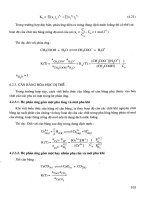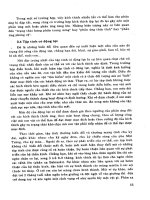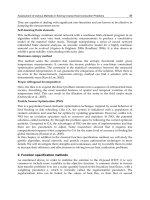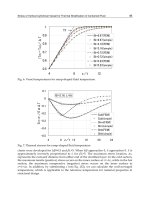Aircraft Structures 1 2011 Part 3 docx
Bạn đang xem bản rút gọn của tài liệu. Xem và tải ngay bản đầy đủ của tài liệu tại đây (1.64 MB, 40 trang )
66
Torsion
of
solid
sections
Am.
r
=
Tr/Ip
where
Ip
=
7ra4/2,
de/&
=
2T/&a4,
P.3.2
Deduce a suitable warping function for the circular section bar of P.3.1 and
w
=
0
everywhere
hence derive the expressions for stress distribution and rate of twist.
Tr
de
T
IP
'
rzs
=
-'
I,
dz
GI,
-
TY
Tx
Ans.
@
=
0,
rzx
=
P.3.3
Show that the warping function
@
=
kxy, in which
k
is an unknown constant,
I,'
rzy
=
-
may be used to solve the torsion problem for the elliptical section of Example 3.1.
P.3.4
Show that the stress function
1
27
'I
2a
(2
+
y2)
-
-
(X3
-
3XY
)
-
-2
is the correct solution for a bar having a cross-section in the form of the equilateral
triangle shown in Fig. P.3.4. Determine the shear stress distribution, the rate of
twist and the warping of the cross-section. Find the position and magnitude of the
maximum shear stress.
Fig.
P.3.4
Am.
dz
rZx
=
-GE
dZ
(y
+
%)
a
dB
r,,
(at centre of each side)
=
-
-
G-
2dz
de
-
15&T
-
dz-Ga4
w
=
L
de
(y3
-
3*y)
2a
dz
Problems
67
Fig.
P.3.5
P.3.5
Determine the maximum shear stress and the rate
of
twist in terms
of
the
applied torque
T
for
the section comprising narrow rectangular strips shown in
Fig.
P.3.5.
A~s.
T~,,,
=
3T/(2a
+
b)t2,
dO/dz
=
3T/G(2a
+
b)t3
Energy methods
of
st
r
uct u ra
I
ana
I
ys
i
s
In Chapter
2
we have seen that the elasticity method of structural analysis embodies
the determination of stresses and/or displacements by employing equations of
equilibrium and compatibility in conjunction with the relevant force-displacement
or stress-strain relationships. A powerful alternative but equally fundamental
approach is the use of energy methods. These, while providing exact solutions for
many structural problems, find their greatest use in the rapid approximate solution
of problems for which exact solutions do not exist. Also, many structures which
are statically indeterminate, that is they cannot be analysed by the application of
the equations of statical equilibrium alone, may be conveniently analysed using an
energy approach. Further, energy methods provide comparatively simple solutions
for deflection problems which are not readily solved by more elementary means.
Generally, as we shall see, modern analysis' uses the methods of
total comple-
mentary energy
and
total potential energy.
Either method may be employed to solve
a particular problem, although as a general rule deflections are more easily found
using complementary energy, and forces by potential energy.
Closely linked with the methods of potential and complementary energy is the
classical and extremely old principle of virtual work embracing the principle of virtual
displacements (real forces acting through virtual displacements) and the principle of
virtual forces (virtual forces acting through real displacements). Virtual work is in fact
an alternative energy method to those of total potential and total complementary
energy and is practically identical in application.
Although energy methods are applicable to a wide range of structural problems and
may even be used as indirect methods of forming equations of equilibrium or
compatibility'>2, we shall be concerned in this chapter with the solution of deflection
problems and the analysis of statically indeterminate structures. We shall also include
some methods restricted to the solution of linear systems, viz. the
unit loadmethod,
the
principle
of
superposition
and the
reciprocal theorem.
Figure 4.l(a) shows a structural member subjected to a steadily increasing load
P.
As
the member extends, the load
P
does work and from the law of conservation
of
energy
4.1
Strain energy and complementary energy
69
Complementary energy C
(a)
(b)
Fig.
4.1
(a) Strain energy of a member subjected to simple tension;
(b)
load-deflection curve for a non-
linearly elastic member.
this
work is stored in the member as strain energy.
A
typical load-deflection curve for
a member possessing non-linear elastic characteristics is shown in Fig. 4.l(b). The
strain energy
U
produced by a load
P
and corresponding extension
y
is then
U=
Pdy
1
and is clearly represented by the area
OBD
under the load-deflection curve. Engesser
(1889) called the area
OBA
above the curve the complementary energy
C,
and from
Fig. 4.l(b)
C=
ydP
(4.2)
I
Complementary energy, as opposed to strain energy, has
no
physical meaning, being
purely a convenient mathematical quantity. However, it is possible to show that
complementary energy obeys the law
of
conservation
of
energy in the type of situation
usually arising in engineering structures,
so
that its use as an energy method is valid.
Differentiation of Eqs
(4.1)
and (4.2) with respect to
y
and
P
respectively gives
dC
dP-'
P,
dU
-=
dY
Bearing these relationships in mind we can now consider the interchangeability of
strain and complementary energy. Suppose that the curve of Fig. 4.l(b) is represented
by the function
P
=
by"
where the coefficient
b
and exponent
n
are constants. Then
U
=
Pdy
=
tJo
PP
(x-'"dP
C=
JIydP=n[by"dy
70
Energy methods
of
structural analysis
Fig.
4.2
Load-deflection curve
for
a linearly elastic
member.
Hence
-=P,
dU
dY
n
dP=n(h)
dU
1
P
'I"
=-y
1
dC dC
dP
-
y,
-
=
bny"
=
nP
dY
(4.3)
(4.4)
When n
=
1
and the strain and complementary energies are completely interchangeable. Such a
condition is found in a linearly elastic member; its related load-deflection curve
being that shown in Fig.
4.2.
Clearly, area OBD(U) is equal to area OBA(C).
It will be observed that the latter of Eqs (4.5) is in the form of what is commonly
known as Castigliano's first theorem, in which the differential of the strain energy
U
of a structure with respect to a load is equated to the deflection of the load. To
be mathematically correct, however, it is the differential of the complementary
energy
C
which should be equated to deflection (compare Eqs (4.3) and (4.4)).
In the spring-mass system shown in its unstrained position in Fig. 4.3(a) we normally
define the potential energy of the mass as the product of its weight,
Mg,
and its height,
h,
above some arbitrarily fixed datum. In other words it possesses energy by virtue of
its position. After deflection to an equilibrium state (Fig. 4.3(b)), the mass has lost an
amount of potential energy equal to Mgy. Thus we may associate deflection with a
loss of potential energy. Alternatively, we may argue that the gravitational force
acting on the mass does work during its displacement, resulting in a loss of energy.
Applying this reasoning to the elastic system of Fig. 4.l(a) and assuming that the
potential energy of the system is zero in the unloaded state, then the
loss
of potential
energy of the load
P
as it produces a deflection y is Py. Thus, the potential energy
V
of
4.3
Principle
of
virtual
work
71
t
Mass
M
1”
t
(a)
(b)
Fig.
4.3
(a) Potential energy
of
a spring-mass system;
(b)
loss
in potential energy due
to
change in position.
P
in the deflected equilibrium state is given by
v
=
-Py
We now define the totalpotential energy (TPE) of a system in its deflected equilibrium
state as the sum
of
its internal or strain energy and the potential energy of the applied
external forces. Hence, for the single member-force configuration
of
Fig. 4.l(a)
TPE=U+V=
Pdy-Py
s:
For a general system consisting of loads
PI, P2,
. . .
,
Pn
producing corresponding
displacements (i.e. displacements in the directions
of
the loads: see Section 4.10)
A,, A2,.
. .
,
A,
the potential energy of all the loads is
and the total potential energy of the system is given by
Suppose that a particle (Fig. 4.4(a)) is subjected to a system
of
loads
PI,
P2,
. . . ,
P,
and that their resultant is
PR.
If
we now impose a small and imaginary displacement,
i.e. a virtual displacement,
6R,
on the particle in the direction
of
PR,
then by the law
of
conservation of energy the imaginary or virtual work done by
PR
must be equal to the
sum
of
the virtual work done by the loads
PI, P2,.
. . ,
P,.
Thus
PR6R
=
PI61
+
P262
+
‘
’
’
+
Pn6n
(4.7)
where
SI,
S2,
. . . ,
6,
are the virtual displacements in the directions
of
PI, P2,.
.
. ,
P,
produced by
SR.
The argument is valid for small displacements only since a significant
change in the geometry of the system would induce changes in the loads themselves.
72
Energy methods
of
structural analysis
Actual
displaced
(a) (b)
Fig.
4.4
(a)
Principle
of
virtual displacements;
(b)
principle
of
virtual forces.
For the case where the particle is in equilibrium the resultant
PR
of the forces must
be zero and Eq. (4.7) reduces to
PIS1
+
P2S2
+
.
+
P,S,
=
0
or
n
c
PrSr
=
0
r=l
The principle of virtual work may therefore be stated as:
A
particle
is
in equilibrium under the action of
a
force system
if
the total virtual work
done by the force system
is
zero for a small virtual displacement.
This statement is often termed the
principle of virtual displacements.
An
alternative formulation of the principle of virtual work forms the basis of the
application of total complementary energy (Section 4.5) to the determination of
deflections of structures.
In
this alternative approach, small
virtual forces
are applied
to a system in the direction of
real displacements.
Consider the elastic body shown in Fig. 4.4(b) subjected to a system of
real loa&
which may be represented by
P.
Due to
P
the body will be displaced such that
points
1,2,.
. .
,n
move through displacements
Al, A2,.
. .
,A,
to
It,
2',
.
. .
,n'.
Now
suppose that small imaginary loads
SPI
,
6P2,
. .
.
,
SP,
were in position and acting in
the directions
of
All
A2,.
. . ,A,
before
P
was applied; since
SP1, SP2,.
. .
,
SP,
are
imaginary they will not affect the real displacements. The total imaginary, or virtual,
work
SW*
done by these loads is then given by
n
SW*
=AlSPl
+
A2SP2+ +AnSP,
=
CAJP,.
which, by the law
of
conservation of energy, is equal to the imaginary, or virtual,
strain energy stored
SU*.
This is due to small imaginary internal forces
SP,
produced
by the external imaginary loads,
moving
through real internal displacements
y
and
r=
1
4.4
Stationary value
of
the total potential energy
73
is given by
Therefore, since
S
W*
=
SU*
(4.9)
Equation (4.9) is known as the
principle
of
virtual forces.
Comparison
of
the right-
hand side of Eq. (4.9) with Eq. (4.2) shows that
SU*
represents an increment in
complementary energy; by the same argument the left-hand side may be regarded
as virtual complementary work.
Although we are not concerned with the direct application of the principle
of
virtual work to the solution of structural problems it is instructive to examine possible
uses of Eqs (4.8) and (4.9). The virtual displacements of Eq. (4.8) must obey the
requirements of compatibility for a particular structural system
so
that their relation-
ship is unique. Substitution of this relationship in Eq. (4.8) results in equations of
statical equilibrium. Conversely, the known relationship between forces may be
substituted in Eq. (4.9) to form equations of geometrical compatibility. Note that
the former approach producing equations of equilibrium is a
displacement method,
the latter giving equations of compatibility of displacement, a
force method.
4.4
The principle
of
the stationary value
of
the
total potential energy
In the previous section we derived the principle of virtual work by considering virtual
displacements (or virtual forces) applied to a particle or body in equilibrium. Clearly,
for the principle to be of any value and for our present purpose of establishing the
principle of the stationary value of the total potential energy, we need to justify its
application to elastic bodies generally.
An elastic body in equilibrium under externally applied loads may be considered to
consist of a system of particles on each of which acts a system of forces in equilibrium.
Thus, for any virtual displacement the virtual work done by the forces on any particle
is, from the previous discussion, zero. It follows that the total virtual work done by all
the forces on the system vanishes. However, in prescribing virtual displacements for
an elastic body we must ensure that the condition of compatibility of displacement
within the body is satisfied and also that the virtual displacements are consistent
with the known physical restraints of the system. The former condition is satisfied
if, as we saw in Chapter
1,
the virtual displacements can be expressed in terms of
single valued functions; the latter condition may be met by specifying zero virtual
displacements at support points. This means of course that reactive forces at supports
do no work and therefore, conveniently, do not enter the analysis.
Let us now consider an elastic body in equilibrium under a series of external
loads,
PI, Pz,
. . .
,
P,,
and suppose that we impose small virtual displacements
SAl, SA2,.
. .
,
SA,
in the directions
of
the loads. The virtual work done by the loads
74
Energy methods of structural analysis
is then
2
PrSAr
r=
1
This
work will be accompanied by an increment of strain energy
SU
in the elastic body
since by specifying virtual displacements of the loads we automatically impose virtual
displacements on the particles of the body itself, as the body is continuous and is
assumed to remain
so.
This
increment in strain energy may be regarded as negative
virtual work done by the particles
so
that the total work done during the virtual
displacement is
n
-SU
i-
PrSAr
r=l
The body is in equilibrium under the applied loads
so
that by the principle of virtual
work the above expression must be equal to zero. Hence
n
SU
-
PJA,
=
0
r=l
(4.10)
The loads
Pr
remain constant during the virtual displacement; therefore, Eq.
(4.10)
may be written
n
SU
-
S
P,Ar
=
0
r=l
or, from Eq.
(4.6)
S(U+
V)
=
0
(4.11)
Thus, the total potential energy of an elastic system has a stationary value for all small
displacements if the system
is
in equilibrium. It may also be shown that if the
stationary value is a
minimum
the equilibrium is stable.
A
qualitative demonstration
of
this fact is sacient for our purposes, although mathematical proofs exist'. In
Fig.
4.5
the positions
A,
B
and
C
of a particle correspond to different equilibrium
states. The total potential energy of the particle in each of its three positions is
proportional to its height
h
above some arbitrary datum, since we are considering a
Fig.
4.5
States
of
equilibrium
of
a particle.
4.4
Stationary value
of
the total potential energy
75
single particle for which the strain energy is zero. Clearly at each position the first
order variation,
a(
U
+
V)/au,
is zero (indicating equilibrium), but only at
B
where
the total potential energy is a minimum is the equilibrium stable. At A and
C
we
have unstable and neutral equilibrium respectively.
To
summarize,
the principle
of
the stationary value
of
the total potential energy
may
be stated
as:
The total potential energy
of
an elastic system has a stationary value for all smull
displacements when the system is in equilibrium; further, the equilibrium is stable
if
the stationary value
is
a minimum.
This principle may often be used in the approximate analysis
of
structures where an
exact analysis does not exist. We shall illustrate the application of the principle in
Example
4.1
below, where we shall suppose that the displaced form
of
the beam is
unknown and must be assumed; this approach is called the
Rayleigh-Ritz
method
(see also Sections
5.6
and
6.5).
Example
4.
I
Determine the deflection of the mid-span point of the linearly elastic, simply sup-
ported beam shown in Fig.
4.6;
the flexural rigidity of the beam
is
EI.
The assumed displaced shape of the beam must satisfy the boundary conditions for
the beam. Generally, trigonometric or polynomial functions have been found to be
the most convenient where, however, the simpler the function the less accurate the
solution. Let
us
suppose that the displaced shape of the beam is given by
TZ
w
=
wB
sin-
L
in which
Q
is the displacement at the mid-span point. From Eq. (i) we see that
w
=
0
when
z
=
0
and z
=
L
and that
v
=
WB
when z
=
L/2.
Also dvldz
=
0
when
z
=
L/2
so that the displacement function satisfies the boundary conditions of the beam.
The strain energy,
U,
due to bending of the beam, is given by (see Ref.
3)
A
wl
B
(ii)
C
//////
Fig.
4.6
Approximate determination
of
beam deflection using total potential energy.
76
Energy methods
of
structural analysis
Also
(iii)
d2v
M
=
-EI-
dz2
(see
Eqs
(9.20))
Substituting in Eq. (iii) for
v
from Eq. (i) and for
M
in
Eq.
(ii) from Eq. (iii)
EI
‘v;7r4
7rz
L
u=-
lo
L4sin
-
dz
which gives
7r4
EIv;
u=
4L3
The total potential energy
of
the beam is then given by
7r4 EIv;
4L3
TPE=U+V=
WVB
Then, from the principle of the stationary value of the total potential energy
w=o
a(
u
+
V)
-
7r4EIV~
~-
-
dVB
2~3
whence
WL3
=
0.02053
-
2 WL’
7r4
EI
EI
?/B
=
~
The exact expression for the mid-span displacement is (Ref.
3)
WL3
=
0.02083
~
WL3
EI
VB
=-
48
EI
Comparing the exact (Eq. (v)) and approximate results (Eq. (iv)) we see that the
difference is less than
2
per cent. Further, the approximate displacement is less than
the exact displacement since, by assuming a displaced shape, we have, in effect,
forced the beam into taking that shape by imposing restraint; the beam is therefore
stiffer.
4.5
The principle
of
the stationary value
of
the
total complementary energy
Consider an elastic system in equilibrium supporting forces
P,
,
P2,
.
. .
P,,
which
produce real corresponding displacements
A,,
A2,.
.
.
A,,.
If we impose virtual
forces
SP,
,
SP2,
.
.
. ,
CiP,,
on the system acting through the real displacements then
the total virtual work done by the system
is,
by the argument of Section
4.4
The first term in the above expression is the negative virtual work done by the
particles in the elastic body, while the second term represents the virtual work
of
4.6
Application to deflection problems
77
the externally applied virtual forces. From the principle of virtual forces, i.e. Eq. (4.9)
-
lv0,
ydP
+
kAr6Pr
=
0
r=
1
(4.12)
Comparing Eq. (4.12) with Eq. (4.2) we see that each term represents an increment in
complementary energy; the first,
of
the internal forces, the second,
of
the external
loads.
Thus
Eq. (4.12) may be rewritten
S(
ci
+
C,)
=
0
(4.13)
where
P
VOI
0
Ci=[
ydP and Ce=-eArPr
r=
1
(4.14)
C,
is in fact the complement of the potential energy
V
of the external loads. We shall
now call the quantity (Ci
+
C,)
the total complementary energy
C
of
the system.
The displacements specified in Eq. (4.12) are real displacements of a continuous
elastic body; they therefore obey the condition of compatibility of displacement
so
that Eqs (4.12) and (4.13) are, in exactly the same way as Eq. (4.9), equations
of
geometrical compatibility. The
principle
of
the stationary value
of
the total complemen-
tary energy
may then be stated as:
For an elastic body in equilibrium under the action
of
applied forces the true internal
forces (or stresses) and reactions are those for which the total complementary energy
has a stationary value.
In other words the true internal forces (or stresses) and reactions are those which
satisfy the condition of compatibility of displacement. This property of the total
complementary energy of an elastic system is particularly useful in the solution of
statically indeterminate structures, in which an infinite number of stress distributions
and reactive forces may be found to satisfy the requirements of equilibrium.
4.6
Application to deflection problems
Generally, deflection problems are most readily solved by the complementary energy
approach, although for linearly elastic systems there is no difference between the
methods of complementary and potential energy since, as we have seen, complemen-
tary and strain energy then become completely interchangeable. We shall illustrate
thc method by reference to the deflections of frames and beams which may or may
not possess linear elasticity.
Let
us
suppose that we require to find the deflection A2 of the load
P2
in the simple
pin-jointed framework consisting, say, of
k
members and supporting loads
PI,
P2,. . .
,
Pn,
as shown in Fig. 4.7. From Eqs (4.14) the total complementary
energy
of
the framework is given by
k
rF
n
c=CJ,'
Xi
dFi
-
ArP,
i=
1
r=
1
(4.15)
78
Energy
methods
of
structural analysis
Fig.
4.7
Determination
of
the deflection
of
a
point on a framework
by
the method
of
complementary energy.
where
Xi
is the extension of the ith member,
Fi
the force in the ith member and
A,
the
corresponding displacement of the rth load
P,.
From the principle of the stationary
value
of
the total complementary energy
from which
(4.16)
(4.17)
Equation (4.16) is seen to be identical to the principle of virtual forces in which virtual
forces
SF
and
SP
act through real displacements
X
and
A.
Clearly the partial
derivatives with respect to
P2
of the constant loads
PI, P2,.
. .
,
P,
vanish, leaving
the required deflection
A,
as the unknown. At this stage, before
A,
can be evaluated,
the load-displacement characteristics of the members must be known. For linear
elasticity
where
Li,
Ai
and
Ei
are the length, cross-sectional area and modulus of elasticity of the
ith member. On the other hand, if the load-displacement relationship is of a non-
linear form, say
Fi
=
b(Xi)c
in which
b
and
c
are known, then
Eq.
(4.17) becomes
The computation of
A,
is best accomplished in tabular form, but before the proce-
dure is illustrated by an example some aspects of the solution merit discussion.
We note that the support reactions do not appear in
Eq.
(4.15). This convenient
absence derives from the fact that the displacements
AI,
A,,
. . .
,
A,
are the real
displacements of the frame and fulfil the conditions of geometrical compatibility
and boundary restraint. The complementary energy of the reaction at
A
and the
4.6
Application to deflection problems
79
vertical reaction at
B
is therefore zero, since both of their corresponding displace-
ments are zero. If we examine Eq. (4.17) we note that
Xi
is the extension of the ith
member of the framework due to the applied loads
PI, P2,.
. .
P,.
Therefore, the
loads
Fj
in the substitution for
Xi
in Eq. (4.17) are those corresponding to the loads
PI; P2,.
. .
,
P,,.
The term
dFi/aP2
in Eq. (4.17) represents the rate
of
change of
Fi
with
P2
and is calculated by applying the load
P2
to the
unloaded
frame and determin-
ing the corresponding member loads in terms of
Pz.
This procedure indicates a
method for obtaining the displacement of either a point
on the frame in a direction
not coincident with the line of action of a load or, in fact, a point such as C which
carries
no
load at all. We place at the point and in the required direction aJictitious
or
dummy
load, say
Pf,
the original loads being removed. The loads in the members
due to
Pf
are then calculated and
aF/dPf
obtained for each member. Substitution in
Eq. (4.17) produces the required deflection.
It must be pointed out that it is not absolutely necessary to remove the actual loads
during the application of
Pf.
The force in each member would then be calculated in
terms of the actual loading and
Pf. Fi
follows by substituting
Pf
=
0
and
dFi/aPf
is
found by differentiation with respect to
Pf.
Obviously the two approaches yield the
same expressions for
Fi
and
aFi/dPf,
although the latter is arithmetically clumsier.
Example
4.2
Calculate the vertical deflection of the point
B
and the horizontal movement of
D
in
the pin-jointed framework shown in Fig. 4.8(a). All members of the framework are
(C)
Fig.
4.8
(a) Actual loading
of
framework;
(b)
determination
of
vertical deflection
of
B;
(c)
determination of
horizontal deflection
of
D.
Table
4.1
0
0 0
@
0
@
0
@x
106
@x
106
Member
L
(mm)
F
(N)
FB,f
(N)
aF&f
/apBqf
FD,f
(N)
aFDsf
laPD.f
FaFB.fIapB,f
F~FDD,fIm,,f
AE 4000J2
-6OOOOJ2
-2J2pB,f/3
-2J213
0
0
320J2
0
EF 4000
-60
000
-2pB,f/3
-213
0
0
160
0
FD 4000J2
-80000J2
-d2PB.f/3
-
~213
0
0
640J213
0
CB 4000
80
000
PB,f/3 113
EB 4000 20
000
2PB,f 13 213
0
0
16013
0
0
0
-
160J2/3
0
FB 4000J2 -20000J2
d2pB.f
13 ~213
DC 4000 80
000
PB,f13
113
pDsf
1
32013 320
PD,f
1 32013 320
1
48013 240
BA 4000 60
000
2pB,f/3
213
pD,f
0
0
0
0
FC 4000
100
000
0
0
C
=
1268
C
=
880
4.6
Application to
deflection
problems
81
linearly elastic and have cross-sectional areas
of
1800~'.
E
for the material
of
the
members is
200
000
N/mm2.
The members of the framework are linearly elastic
so
that
Eq.
(4.17) may be written
or, since each member has the same cross-sectional area and modulus of elasticity
A
-XF.L
1
8Fi
AE.
lap
r=l
(ii)
The solution is completed in Table 4.1, in which
F
are the member forces due to the
actual loading of Fig. 4.8(a),
FB,f
are the member forces due
to
the fictitious load
PB,f
in Fig. 4.8(b) and
FD,f
are the forces in the members produced by the fictitious load
PD,p
in Fig. 4.8(c). We take tensile forces as positive and compressive forces as
negative.
The vertical deflection of
B
is
=
3.52mm
1268
x
lo6
AB:v
=
1800
x
200
000
and the horizontal movement
of
D
is
=
2.44~
880
x
lo6
=
1800
x
200 000
The positive values
of
AB,"
and
AD.h
indicate that the deflections are in the directions
of
PB,f
and
PD,p
The analysis of beam deflection problems by complementary energy is similar to
that of pin-jointed frameworks, except that we assume initially that displacements
are caused primarily by bending action. Shear force effects are discussed later in
the chapter. Figure 4.9 shows a tip loaded cantilever of uniform cross-section and
length
L.
The tip load
P
produces a vertical deflection
A,
which we require to find.
'Centre
of
curvature at section
z
Fig.
4.9
Beam deflection
by
the method of complementary energy.
82
Energy methods
of
structural analysis
The total complementary energy
C
of the system is given by
C=~L~~dOdM- PA, (4.18)
in which
J,
de
dM is the complementary energy
of
an element Sz of the beam. This
element subtends an angle
Sf3
at its centre of curvature due to the application of the
bending moment
M.
From the principle of the stationary value of the total comple-
mentary energy
or
(4.19)
elastic beam.
To
-
0)
and bending
Equation (4.19) is applicable to either a non-linear or linearly
proceed further, theifore, we require the load-displacement
(M
moment-load
(M
-
P)
relationships. It is immaterial for the purposes of this illustra-
tive problem whether the system is linear or non-linear, since the mechanics of the
solution are the same in either case. We choose therefore a linear
M
-
0
relationship
as this is the case in the majority of the problems we consider. Hence from Fig. 4.9
,
se
=
KSZ
or
from simple beam theory
where the product
modulus
of
elasticity
x
second moment
of
area
of
the beam
cross
section
is known as the
bending orpexural rigidity
of the beam.
Also
M
=
Pz
so
that
dM
Substitution for de,
M
and dM/dP in Eq. (4.19) gives
or
The
fictitious load method of the framework example may be employed in the
solution of beam deflection problems where we require deflections at positions on
the beam other than concentrated load points. Suppose that we are to find the tip
deflection AT of the cantilever of the previous example in which the concentrated
load has been replaced by a uniformly distributed load of intensity
w
per unit
4.6
Application to deflection problems
83
w/un
i
t
length
Pf
.
-1
AT
t
L
I
Fig.
4.10
Deflection of a uniformly loaded cantilever by the method of complementary energy.
length (see Fig. 4.10). First we apply a fictitious load
Pf
at the point where the deflec-
tion is required. The total complementary energy of the system is
C
=
IL
1;
dt'dM
-
ATP,
-
Awdz
c
where the symbols take their previous meanings and A is the vertical deflection of any
point
on
the beam. Then
(4.20)
As
before
M
EI
dt'
=
-
dz
but
Hence
W2
M
=
PfZ
+
-
(Pf
=
0)
2
Substituting in Eq. (4.20) for de,
M
and dM/dPf, and remembering that
Pf
=
0,
we
have
giving
wL4
AT
=-
8
EI
It will be noted that here, unlike the method for the solution of the pin-jointed
framework, the fictitious load is applied to the loaded beam. There is, however, no
arithmetical advantage to be gained by the former approach although the result
would obviously be the same since
M
would equal
w2/2
and
aM/aPf
would have
the value
z.
84
Energy
methods
of
structural analysis
Ip
+Lp
+*
4
0,t
2
C,t
-
2
-
L
+
L
:z
Fig.
4.1
1
Deflection
of
a simply
supported
beam by the
method
of
complementary energy.
Example
4.3
Calculate the vertical displacements
of
the quarter and mid-span points
B
and C
of
the simply supported beam
of
length
L
and flexural rigidity
EI
loaded, as shown in
Fig.
4.1
1.
The total complementary energy
C
of the system including the fictitious loads
PB.f
and
Pc,f
is
L
c
=
IL
jbMdsdM
-
PB,&
-
PqAC
-
lo
Awdz
-=/Lde~-A~=O
dC dM
=hdsap,,-AC=O dC
dM
(0
Hence
(ii)
apB;f
and
aPc,f
Assuming a linearly elastic beam,
Eqs
(ii) and (iii) become
From
A
to
B
(iii)
thus
4.7
Solution
of
statically indeterminate systems
85
From
B
to
C
giving
From
C
to
D
so
that
=
i(L
-
z)
-=$(L-z),
-
dPB,f
apt,,
dM
dM
Substituting these values in
Eqs
(iv) and (v) and remembering that
PB,f
=
Pc,f
=
0
we
have, from
Eq.
(iv)
from which
1 19wL4
B
-
24 576EI
A-
Similarly
5wL4
A,=-
384EI
The fictitious load method of determining deflections may be streamlined for
linearly elastic systems and is then termed the
unit
loud
method;
this we shall discuss
later in the chapter.
In a statically determinate structure the internal forces are determined uniquely by
simple statical equilibrium considerations. This is not the case for a statically indeter-
minate system in which, as we have already noted, an infinite number of internal force
or stress distributions may be found to satisfy the conditions of equilibrium. The true
force system is, as we demonstrated in Section
4.5,
the one satisfying the conditions of
compatibility of displacement of the elastic structure or, alternatively, that for which
the total complementary energy has a stationary value. We shall apply the principle to
86
Energy methods
of
structural analysis
B
C
Fig.
4.12
Analysis
of
a
statically indeterminate framework by the method
of
complementary energy.
a variety of statically indeterminate structures, beginning with the relatively simple
singly-redundant pin-jointed frame shown in Fig.
4.12
in which each member has
the same value of the product
AE.
The first step is to choose the redundant member. In this example no advantage is
gained by the choice of any particular member, although in some cases careful
selection can result in a decrease in the amount of arithmetical labour. Taking
BD
as the redundant member we assume that it sustains a tensile force
R
due to the
external loading. The total complementary energy of the framework is, with the
notation of
Eq.
(4.15)
C
=
21:
AidFi
-
PA
i=
1
Hence
dC
dFi
dR
.
dR
-
=
Ai
-
=
0
1=
1
or, assuming linear elasticity
Ik
dFi
-E
F~L~~
=
o
AE.
1=1
(4.21)
(4.22)
The solution is now completed in Table
4.2
where, as in Table
4.1,
positive signs
indicate tension.
Table
4.2
0
0
Member
Length
0
F
4.7
Solution
of
statically indeterminate systems
87
Hence from
Eq.
(4.22)
4.83lU
+
2.707PL
=
0
or
R
=
-0.56P
Substitution for
R
in column
@
of Table
4.2
gives the force in each member. Having
determined the forces in the members then the deflection of any point on the frame-
work may be found by the method described in Section
4.6.
Unlike the statically determinate type, statically indeterminate frameworks may be
subjected
to
self-straining. Thus, internal forces are present before external loads are
applied. Such a situation may be caused by a local temperature change or by an initial
lack of fit of a member. Suppose that the member BD of the framework
of
Fig.
4.12
is
short by a known amount
AR
when the framework is assembled but is forced to fit.
The load
R
in BD will then have suffered a displacement
AR
in addition to that caused
by the change in length of BD produced by the load
P.
The total complementary
energy is then
and
dC
dFi
-
=
dR
r=l
.
dR
Xi-
-
AR
=
0
or
1
8Fi
AR
=
-E
AE.
~~1,~-
dR
r=l
(4.23)
Obviously the summation term in
Eq.
(4.23)
has the same value as in the previous case
so that
AE
R
=
-0.56P
+
-
4.831,
AR
Hence the forces in the members are due to both applied loads and an initial lack of
fit.
Some care should be given to the sign of the lack of fit
AR.
We note here that the
member BD is short by an amount
AR
so that the assumption of a positive sign for
AR
is compatible with the tensile force
R.
If BD were initially
too
long then the total
complementary energy
of
the system would be written
C=xj:AidFi-PA-R(-AR)
k
i=
1
giving
1
aFi
-AR
=
-E
FiLi-
AE.
1=1
88
Energy methods
of
structural analysis
Fig.
4.1
3
Framework
of
Example
4.4.
Example
4.4
Calculate the loads in the members of the singly redundant pin-jointed framework
shown in Fig. 4.13. The members AC and BD are 30 mm2 in cross-section, and all
other members are 20mm2 in cross-section. The members AD, BC and DC are
each
800
mm
long.
E
=
200
000
N/mm2.
From the geometry of the framework AFD
=
CTD
=
30"; therefore BD
=
AC
=
800fimm.
Choosing CD as the redundant member and proceeding from
Eq.
(4.22)
we have
0
Le
FiLi
aFi
=
E
Ai
dR
i=
1
From Table 4.3 we have
-
-268
+
129.2R
=
0
i=
1
Hence
R
=
2.1
N
and the forces in the members are tabulated in column
0
of
Table 4.3.
Table
4.3
(Tension
positive)
0
0
0
@
Member
L(mm)
A(m2)
F(N)
@
0
Force (N)
0
6'FIaR (FL/A)aF/aR
AC
800J3
30
50
-
J3R/2 -J3/3/2 -2000
+
20J3R 48.2
CB
800
20
86.6
+
R/2
112 1732
+
10R
87.6
-1.8
BD
800J3 30 -J3R/2 -J3/3/2 20J3R
CD
800
20 R
1
40R 2.1
AD
800
20 RI2 112 IOR
1
.o
C
=
-268
+
129.2R
Example
4.5
A
plane, pin-jointed framework consists of six bars forming a rectangle ABCD
4000
mm by
3000
mm with two diagonals, as shown in Fig. 4.14. The cross-sectional
area of each bar is
200
mm2 and the frame is unstressed when the temperature of each
member is the same. Due to local conditions the temperature of one of the 3000
mm
4.7
Solution of statically indeterminate systems
89
Fig.
4.14
Framework
of
Example
4.5.
members is raised by 30°C. Calculate the resulting forces in all the members if the
coefficient of linear expansion
Q!
of the bars is
7
x
10-6/"C.
E
=
200000N/mm2.
Suppose that BC is the heated member, then the increase in length of
BC
=
3000
x
30
x
7
x
lop6
=
0.63
mm. Therefore, from Eq.
(4.23)
dFi
FiLi
-
dR
1
200
x
200000.
-0.63
=
2=1
Substitution from the summation of column
@
in Table
4.4
into Eq. (i) gives
-0.63
x
200
x
200000
48
000
=
-525N
R=
Column
@
of Table
4.4
is now completed for the force in each member.
So
far, our analysis has been limited to singly redundant frameworks, although the
same procedure may be adopted to solve a multi-redundant framework of, say,
nz
redundancies. Thus, instead of a single equation of the type (4.21) we would have
m
simultaneous equations
from which the
m
unknowns
R1, R2,.
.
.
,
R,
would be obtained. The forces
F
in the
members follow, being expressed initially in terms of the applied loads and
R17R27.
. .
,R,,-
Other types of statically indeterminate structure are solved by the application of
total complementary energy with equal facility. The propped cantilever of Fig.
4.15
Table
4.4
(Tension
positive)
G3
Force
(N)
64
000R/9 -700
3
OOOR
-525
64
000R/9
-700
3
OOOR
-525
AB
4000
4R/3
413
CD
4000
4R/3
413
BC
3000
R
1
DA
3000 R
1
AC
5000
-5R/3
-513
125
000R/9 875
DB
5000
-5R/3
-513
125
000R/9 875
C
=
48
OOOR
90
Energy methods
of
structural analysis
Fig.
4.15
Analysis
of
a propped cantilever
by
the method
of
complementary energy.
is an example of a singly redundant beam structure for which total complementary
energy readily yields a solution.
The total complementary energy of the system is, with the notation of Eq. (4.18)
c
=
jL
IrdOdM
-
PAC
-
RBAB
where Ac and AB are the deflections at
C
and
B
respectively. Usually, in problems of
this type, AB is either zero for a rigid support, or a known amount (sometimes in
terms
of
RB) for a sinking support. Hence, for a stationary value of
C
from which equation RB may be found; RB being contained in the expression for the
bending moment
M.
Obviously the same procedure is applicable to a beam having a multiredundant
support system,
viz.
a continuous beam supporting a series of loads
P1, Pz,
. .
.
,
P,,.
The total complementary energy
of
such a beam would be given by
where Rj and A, are the reaction and known deflection (at least in terms of Rj) of the
jth
support point in a total of
m
supports. The stationary value of
C
gives
producing
m
simultaneous equations for the
m
unknown reactions.
The intention here is not to suggest that continuous beams are best or most readily
solved by the energy method; the moment distribution method produces a more rapid
solution, especially for beams in which the degree
of
redundancy is large. Instead the
purpose is to demonstrate the versatility and power of energy methods in their ready
solution of a wide range of structural problems. A complete investigation of this
versatility is impossible here due to restriction of space; in fact, whole books have
been devoted to this topic. We therefore limit our analysis to problems peculiar to
the field of aircraft structures with which we are primarily concerned. The remaining
portion of this section is therefore concerned with the solution of frames and rings
possessing varying degrees of redundancy.
The frameworks we considered in the earlier part of this section and in Section 4.6
comprised members capable of resisting direct forces only. Of a more general type are
composite frameworks in which some or all of the members resist bending and shear









